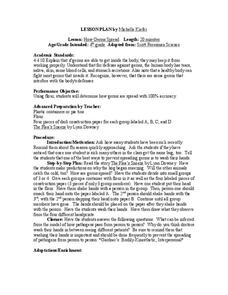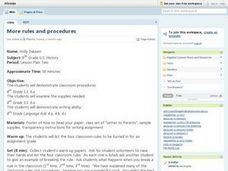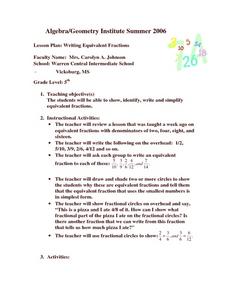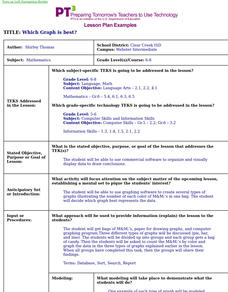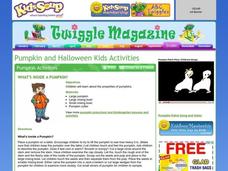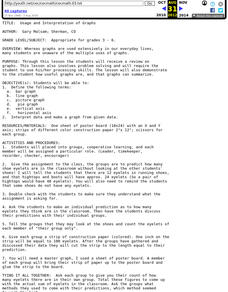Curated OER
Fun With Fractions
Students play a math game to gain a better understanding of fractions after visiting the American Revolution in the Time Machine. Students attempt to purchase pies from a local farmer. Students use sheets of paper to show knowledge of...
Curated OER
Dynamite Data
Second graders rotate through a variety of stations designed to offer practice in manipulating data. They sort, tally and count items and then create bar graphs, tables, and pie graphs to record their findings.
Curated OER
How Germs Spread
Fourth graders investigate how germs spread in this lesson. They listen to "The Flea's Sneeze" by Lynn Downey and make predictions on why the hog began sneezing. They then conduct an experiment using flour and paper cups demonstrating...
Curated OER
Creating Circle Graphs with Microsoft Excel
Students create graphs of circles. In this geometry lesson, students use Microsoft Excel to create graphs. They construct the graphs using paper and pencil as well as the computer.
Curated OER
Noun/Adjective/Subject/Verb Agreement
Students create a wheel from construction paper to use to create sentences. The wheel consists of four concentric circles, beginning with the largest being 8 inches in diameter. Each circle represents one part of a sentence. Students...
Curated OER
More Rules and Procedures
Young scholars investigate classroom rules, procedures and expectations given by the teacher. They discuss the analogy of needing ingredients and supplies to bake a pie and needing ingredients and supplies to do their school work. ...
Curated OER
Writing Equivalent Fractions
Fifth graders work to find the fractions that are equal to one another. They use a visual pie graph to show different values. Students are able to see how fractions can look different, yet have the same value.
Curated OER
Opposites Attract
Students demonstrate the attraction of small pieces of paper to a charged plastic rod and conduct experiment with other objects to determine whether they can hold a charge. They then use online applets to apply their experiments to...
Curated OER
Alphabet People
Students create alphabet people out of pipe cleaners, hole punchers, white paper, crayons, and tape. In this alphabet people lesson plan, students then complete activities with the letter of their alphabet person.
Curated OER
Complex numbers in polar form
Students plot complex numbers in the polar plane. They are asked to list what they believe are the five most famous numbers in mathematics. Students are explained that generally accepted that the five most famous numbers in mathematics...
Curated OER
Convection in a Pan
Students watch a demonstration using a plastic bag and a hair dryer to create a hot air balloon. After the demonstration, they discuss the results and whether or not hot water behaves the in the same manner as hot air. They conduct...
Curated OER
Graphing Using Cookies
Learners differentiate between bar graphs, line graphs, pictographs and bar graphs. After participating in a hands-on cookie activity, students label and draw their own graphs.
Curated OER
Which Graph is best?
Students use commercial software to organize and visually display data to draw conclusions; students use graphing software to create several types of graphs illustrating the number of each color of M&M's in one bag.
Curated OER
Australian Settlers
Young scholars interpret graphs and research events to identify links between events in the world and the arrival and plight of immigrant groups. They discuss the myths about immigration.
Curated OER
Bingo Dabber Pictures
Students make dot pictures using bingo marker dabbers. In this art lesson, students enjoy making dots and creating pictures out of the dots.
Curated OER
What's Inside a Pumpkin?
Students explore the properties of a pumpkin. In this What's Inside a Pumpkin lesson plan, students use a real pumpkin to investigate pumpkin facts, sing a song "Five Little Pumpkins", paint pumpkin patch artwork, participate in a...
Curated OER
A Hair Raising Experience
Students rotate through various lab stations in groups as they experiment with the concepts of conduction, induction and friction. They use a generator, aluminum pie pans, paper, plastic, styrofoam and other materials to complete their...
Curated OER
Sing, Sing, What Shall I Sing?
Students view "Baby and I Were Baked in a Pie" and "Rain, Rain, Go Away" posters on the board. They also view "Sing, Sing, What Shall I sing?" poster, students are shown the cat playing with the ball of string. Students are asked if...
Curated OER
Ruler Race
In this length measurements worksheet, students play a game with a partner that helps them measure the three lengths on the pie charts. Students spin a pencil or paper clip to find the measurement and use a ruler to draw the length from...
Curated OER
Exploring Electricity - Four Activities
These are four classic activities used for instructing upper elementary electricians. The first involves experimenting with the Van de Graaff generator. The second is a series of hands-on experiences with static. In the third activity,...
Curated OER
Usage and Interpretation of Graphs
Students review graphing and use processing skills to solve problems.
Curated OER
Everybody Needs a Little Sunshine
Three activities introduce upper elementary ecologists to photosynthesis and food webs. In the first, an experiment is set up to determine how plants respond to different types of light. In the second, they connect organism cards with...
Curated OER
pH Basics
At some point, all science learners experiment with pH. In this brief lesson, they simply use pH strips or a meter to find the pH of six different solutions. A useful worksheet that displays a data chart is included for your students.
Curated OER
Effect of Technology on the Environment
There's no doubt that one of the most consistent dangers to our environment is the risks associated with the extraction and shipment of oil. This lesson focuses on oil spills - how they happen, the effects they have on the environment,...




